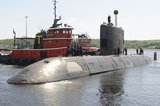Raytheon wins Tomahawk missile contract
Raytheon will build and deliver Tomahawk Block IV cruise missiles for the US Navy and Royal Navy under a $251 million contract announced on 26 September. The contract covers missiles for fiscal year 2014 an includes an option for 2015.
Raytheon will also conduct flight tests and provide life-cycle support for the US Navy and Royal Navy under the contract, with delivery scheduled to begin in 2015.
The Tomahawk Block IV missile includes a two-way satellite data-link that enables a strike controller to flex the missile in-flight to pre-programmed alternate targets or redirect to an alternate or more time critical target.
The surface and submarine-launched precision strike stand-off weapon has a range of more than 1,000 miles, and is designed for long-range precision strike missions against high-value and heavily defended targets.
Capt. Joseph Mauser, US Navy Tomahawk program manager, said: ‘Tomahawk Block IV continues to be our nation's weapon of choice to defeat high value targets and integrated air defence systems. With more than 2,000 combat missions and 500 successful flight tests, Tomahawk has proven its outstanding reliability and effectiveness.’
Mike Jarrett, air warfare systems vice president, Raytheon, added: ‘Tomahawk's record of reliability, effectiveness and accuracy is unmatched by any other tactical cruise missile in the world today. Raytheon and the US Navy are working to bring even greater capability to this already sophisticated weapon.’
Tomahawk is integrated on all major US surface combatants and US and UK sub-surface platforms including the Los Angeles, Virginia and Ohio, Astute and Trafalgar class submarines.
More from Naval Warfare
-
![Maritime defence in the Mediterranean faces challenges from vulnerable land power]()
Maritime defence in the Mediterranean faces challenges from vulnerable land power
As an indispensable energy crossroads, the Mediterranean is at serious risk from grey zone disruption. As navies increasingly employ AI data centres, what happens when cutting-edge defence technologies rely on the very infrastructure most susceptible to hybrid tactics?
-
![US Navy to conduct an experimentation campaign with emerging tech in 2026 and 2027]()
US Navy to conduct an experimentation campaign with emerging tech in 2026 and 2027
The Technology Operational Experimentation Events will inform future requirements as the US Navy looks for innovative solutions across three key operational domains.
-
![Future Canadian Continental Defence Corvette will provide “Halifax-equivalent capabilities”]()
Future Canadian Continental Defence Corvette will provide “Halifax-equivalent capabilities”
Although the CDC project is still in its early stages, the Canadian Department of National Defence already has some requirements for the future platforms.





















